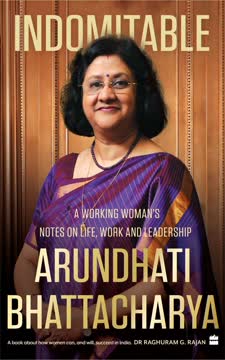Key Takeaways
1. From Small-Town Roots to Banking Leadership: Arundhati Bhattacharya's Journey
"I may never have been born at all!"
Humble beginnings. Arundhati Bhattacharya's journey from a small-town girl to the first woman chairperson of State Bank of India is a testament to perseverance and adaptability. Born into a middle-class family in Bhilai, she experienced the challenges of a developing India firsthand. Her early years were marked by financial struggles, frequent relocations, and the balancing act of education and family responsibilities.
Formative experiences. Key experiences shaped her outlook:
- Living in a developing steel township, witnessing India's industrial growth
- Overcoming health challenges and academic hurdles
- Adapting to new environments with each family relocation
- Learning the value of education and hard work from her parents
These experiences instilled in her the resilience, adaptability, and empathy that would later define her leadership style at SBI.
2. Navigating Career Challenges and Growth in State Bank of India
"I felt deeply grateful to my team for stepping up so seamlessly to the challenge."
Early career challenges. Bhattacharya's journey in SBI was marked by numerous challenges that shaped her leadership approach:
- Adapting to diverse roles across different departments
- Balancing work demands with family responsibilities
- Overcoming gender biases in a male-dominated industry
- Navigating complex organizational structures and bureaucracy
Key growth moments:
- Learning from mentors and supportive colleagues
- Taking on challenging assignments that pushed her out of her comfort zone
- Developing a collaborative leadership style
- Embracing continuous learning and adaptability
Her experiences taught her the importance of teamwork, empathy, and innovation in overcoming organizational challenges, setting the stage for her future role as a transformative leader.
3. Transforming SBI: Digital Innovation and Customer-Centric Approaches
"I wanted to have an application that would enable our customers to seamlessly conduct banking as well as allow them to do all other activities, such as shopping, booking shows, surfing, connecting to social media platforms – that is, doing everything through a single application."
Digital transformation. Under Bhattacharya's leadership, SBI underwent a significant digital transformation:
- Launch of YONO (You Only Need One) app, integrating banking with lifestyle services
- Implementation of advanced analytics and AI for better customer service
- Upgrading core banking systems and network infrastructure
- Introducing digital branches and self-service kiosks
Customer-centric initiatives:
- Simplifying processes for account opening and loan applications
- Enhancing mobile and internet banking platforms
- Introducing innovative products tailored to different customer segments
- Improving customer experience through technology and training
These initiatives not only modernized SBI but also positioned it to compete effectively with new-age banks and fintech companies, significantly improving customer satisfaction and market share.
4. Managing Stressed Assets and Economic Challenges in Indian Banking
"I felt that we first needed to stem the flood to allow waters to recede."
Tackling NPAs. Bhattacharya faced the critical challenge of managing Non-Performing Assets (NPAs) in a challenging economic environment:
- Implementing early warning systems for detecting potential defaults
- Restructuring loans for viable businesses
- Advocating for policy changes to address systemic issues in sectors like power and infrastructure
- Balancing recovery efforts with continued lending to support economic growth
Strategic approach:
- Segmenting NPAs by sector and size for tailored solutions
- Collaborating with government and regulators for policy reforms
- Strengthening risk management and credit assessment processes
- Focusing on retail and SME sectors to diversify loan portfolio
Her approach emphasized not just recovery but also prevention and systemic reforms, setting a new standard for NPA management in Indian banking.
5. Spearheading Financial Inclusion: The Jan Dhan Yojana Initiative
"SBI alone had opened 110 million accounts."
Massive undertaking. The Prime Minister's Jan Dhan Yojana (PMJDY) was a landmark initiative in financial inclusion, with SBI playing a pivotal role:
- Opening millions of bank accounts for the unbanked population
- Setting up customer service points in remote areas
- Issuing RuPay debit cards with inbuilt accident insurance
- Integrating accounts with Aadhaar and mobile numbers (JAM trinity)
Impact and challenges:
- Enabling direct benefit transfers, reducing leakages in government subsidies
- Promoting financial literacy and access to banking services
- Overcoming logistical challenges in remote areas
- Managing the sudden influx of new customers and accounts
This initiative not only transformed the banking landscape but also empowered millions of Indians, particularly in rural and underserved areas, with access to formal banking services.
6. Steering Through Demonetization: A Test of Leadership and Resilience
"The next sixty days tested our skills for negotiating the unknown and uncertain in ways that we had never imagined."
Crisis management. The sudden demonetization announcement in 2016 presented unprecedented challenges:
- Managing massive crowds and ensuring orderly exchange of old notes
- Rapidly recalibrating ATMs for new currency notes
- Implementing frequent policy changes from the government and RBI
- Ensuring adequate cash supply across branches nationwide
Leadership in action:
- Rapid communication and coordination across all levels of the bank
- Innovative solutions like token systems to manage crowds
- Motivating staff working under extreme pressure
- Transparent communication with the public to maintain trust
Bhattacharya's leadership during this crisis demonstrated SBI's resilience and adaptability, reinforcing its role as India's premier banking institution.
7. Merger of SBI with Associate Banks: A Landmark in Indian Banking
"I do not believe that such an exercise of merging six banks with one entity in one go has ever been attempted and completed so smoothly anywhere else in the world."
Massive consolidation. The merger of SBI with its associate banks was a landmark event in Indian banking:
- Consolidating six associate banks and Bharatiya Mahila Bank with SBI
- Creating a banking behemoth with enhanced capabilities and reach
- Streamlining operations and eliminating redundancies
- Harmonizing diverse organizational cultures and systems
Key challenges and solutions:
- Integrating diverse IT systems and databases
- Managing human resources and addressing employee concerns
- Aligning policies and procedures across merged entities
- Ensuring smooth transition for customers
This merger not only strengthened SBI's position but also set a precedent for future consolidations in the Indian banking sector.
8. Revolutionizing Human Resources in SBI: Project Saksham
"Project Saksham, one of the world's largest data-driven and tech-enabled career development system (CDS)."
HR transformation. Bhattacharya initiated a comprehensive overhaul of SBI's human resources practices:
- Implementing a data-driven performance appraisal system
- Creating clear career paths and succession planning
- Introducing specialized roles and skill development programs
- Modernizing recruitment and employee engagement processes
Key innovations:
- Digital tools for manpower assessment and posting
- Self-learning modules for continuous skill development
- Cohort-based grading system for fair performance evaluation
- Focus on employee well-being and work-life balance
This transformation aimed to create a more dynamic, skilled, and motivated workforce, capable of meeting the challenges of modern banking.
9. Balancing Work and Family: Personal Insights from a Banking Leader
"I don't know how I managed it. But I did manage, and I think women get endowed with superpowers when they hold a baby in their arms."
Personal challenges. Bhattacharya's journey highlights the unique challenges faced by women in leadership roles:
- Balancing demanding career with family responsibilities
- Managing frequent relocations and their impact on family
- Dealing with societal expectations and gender biases
- Caring for a child with special needs while managing a high-pressure job
Strategies for balance:
- Building a strong support system at home and work
- Prioritizing effectively and learning to delegate
- Embracing flexibility and technology to manage time better
- Advocating for policies that support working parents
Her experiences offer valuable insights into the challenges and strategies for achieving work-life balance in high-pressure careers, particularly for women in leadership roles.
Last updated:
FAQ
1. What’s Indomitable: A Working Woman’s Notes on Work, Life and Leadership by Arundhati Bhattacharya about?
- Memoir of a trailblazer: The book is a memoir chronicling Arundhati Bhattacharya’s journey from her modest upbringing to becoming the first woman chairperson of the State Bank of India (SBI).
- Personal and professional challenges: It intertwines her personal life, including family and motherhood, with her professional ascent in a male-dominated industry.
- India’s transformation lens: The narrative reflects India’s social and economic evolution, especially regarding women’s roles and the modernization of the banking sector.
- Leadership and change: Bhattacharya shares insights on leadership, organizational transformation, and the challenges of driving change in a large public institution.
2. Why should I read Indomitable by Arundhati Bhattacharya?
- Inspiration for women and leaders: The book offers a candid account of breaking gender barriers, inspiring readers—especially women—to pursue leadership roles.
- Insider’s view of Indian banking: It provides a rare perspective on the evolution, challenges, and reforms within India’s largest bank.
- Practical leadership lessons: Readers gain actionable insights on collaboration, risk management, and empowering teams in large organizations.
- Work-life balance realities: The memoir offers honest reflections on balancing a demanding career with family, making it relatable for working professionals.
3. What are the key takeaways from Indomitable by Arundhati Bhattacharya?
- Unstoppable mindset: Perseverance, self-belief, and resilience are essential for overcoming personal and professional obstacles.
- People-first leadership: Empowering employees, fostering collaboration, and backing courageous decisions are central to her leadership philosophy.
- Work-life integration: Sustainable balance between work and family is crucial, and practical support systems matter more than the ‘superwoman’ myth.
- Breaking stereotypes: Determination and continuous learning can help break gender norms and succeed in traditionally male-dominated fields.
4. How does Arundhati Bhattacharya describe her early life and influences in Indomitable?
- Humble beginnings: Growing up in small steel towns, her family’s sacrifices and values shaped her resilience and outlook.
- Value of education: Her mother’s emphasis on books and her father’s equal treatment of children fostered confidence and a love of learning.
- Early leadership skills: School activities like debating and acting helped her develop communication and leadership abilities.
- Overcoming challenges: She learned to find her strengths despite physical and social challenges in her formative years.
5. What major challenges did Arundhati Bhattacharya face as a woman in banking, according to Indomitable?
- Gender bias and stereotypes: She encountered assumptions about women’s roles, less glamorous assignments, and skepticism about balancing work and family.
- High expectations: She was expected to perform at or above the level of male colleagues, often working long hours and handling difficult situations.
- Workplace dynamics: Managing union politics, staff dynamics, and resistance to change were ongoing challenges.
- Motherhood and career: Balancing a demanding job with caring for a daughter with special needs required strong support systems and policy advocacy.
6. What leadership and management lessons does Arundhati Bhattacharya share from her SBI tenure in Indomitable?
- Empowerment and trust: She emphasizes empowering employees, getting their buy-in, and supporting their decisions to foster accountability.
- Collaboration over territoriality: Bhattacharya highlights the advantage of collaborative leadership, especially for women, in driving large-scale change.
- People-centric policies: She introduced employee-friendly policies like two Saturdays off, sabbaticals, and flexible work arrangements.
- Handling resistance: Overcoming roadblocks required staying grounded, seeking help, and maintaining focus on organizational goals.
7. How did Arundhati Bhattacharya approach risk management and NPA resolution at SBI, as described in Indomitable?
- Elevating risk function: She created a board-level MD role for risk and compliance, giving the function authority and independence.
- Early warning systems: Technology-driven systems were implemented to detect stress signals and enable timely intervention.
- Segmented asset strategies: Different approaches were used for corporate, SME, agriculture, and retail NPAs, with tailored monitoring and resolution.
- Advocacy for legal reforms: She pushed for bankruptcy law reforms to improve the resolution of stressed assets.
8. What were the key digital transformation initiatives led by Arundhati Bhattacharya at SBI in Indomitable?
- Network upgrades: SBI moved to MPLS technology, improving bandwidth and network stability across thousands of branches.
- Customer experience improvements: Initiatives like queue management, self-service kiosks, and branch redesigns enhanced service quality.
- In-touch branches: Modernized branches with digital features and virtual consultations targeted younger customers.
- YONO platform: She conceptualized the “You Only Need One” app to integrate banking and lifestyle services, laying the groundwork for SBI’s digital future.
9. How did Arundhati Bhattacharya balance her demanding career with family life, according to Indomitable?
- Support system reliance: She depended on her husband, aunt, and a trusted helper to care for her daughter with special needs.
- Difficult decisions: Choices like sending her daughter to India for better care highlight the emotional challenges of balancing work and family.
- Policy advocacy: She championed sabbaticals and five-day workweeks to support working parents.
- Educational support: Bhattacharya sought specialized schools and tutors for her daughter while managing her own professional responsibilities.
10. What human resource reforms and people-centric policies did Arundhati Bhattacharya implement at SBI, as detailed in Indomitable?
- Career development system: Project Saksham introduced measurable KRAs, continuous evaluation, and transparent promotions.
- Grievance and transfer reforms: A grievance portal and employee posting preferences improved satisfaction and reduced disruptions.
- Inclusion and diversity: Sabbaticals for women, promotion of women to senior roles, and integration of employees with disabilities were key initiatives.
- Learning and communication: Internal blogging, online learning modules, and feedback platforms fostered a culture of continuous improvement.
11. How does Indomitable portray the evolution of India and the banking sector through Arundhati Bhattacharya’s life?
- From limited opportunities to leadership: The book traces India’s growth from few career options for women to Bhattacharya’s historic leadership at SBI.
- Banking sector modernization: Her career mirrors the sector’s transformation, including HR reforms, mega-mergers, and digitalization.
- Cultural and technological shifts: The narrative covers India’s journey from traditional to digital banking and broader societal changes.
- Personal lens on progress: Bhattacharya’s story illustrates the interplay between personal ambition and national development.
12. What are the best quotes from Indomitable by Arundhati Bhattacharya and what do they mean?
- “Nothing is impossible, the word itself says ‘I’m possible!’” – Emphasizes optimism and determination in overcoming challenges.
- “The word ‘arundhati’...one who cannot be stopped or one who is unstoppable.” – Reflects her indomitable spirit and life philosophy.
- “Work is transitory, family and friends are not, and the balance must be found.” – Highlights the importance of prioritizing relationships alongside career.
- “Poverty is the worst form of violence.” – Underlines the moral imperative of financial inclusion and social responsibility in banking.
- “Books are our best friends.” – Stresses the lifelong value of learning and knowledge, a lesson from her mother.
Review Summary
Indomitable is a well-received autobiography by Arundhati Bhattacharya, former Chairperson of the State Bank of India. Readers praise her inspiring journey from a small town to leading India's largest bank. The book offers insights into work-life balance, challenges faced by women in leadership, and banking sector reforms. Many appreciate her writing style, humor, and honesty in discussing personal and professional struggles. While some find the banking jargon heavy, most consider it a motivational read, especially for working women aspiring to climb the corporate ladder.
Similar Books










Download PDF
Download EPUB
.epub digital book format is ideal for reading ebooks on phones, tablets, and e-readers.





